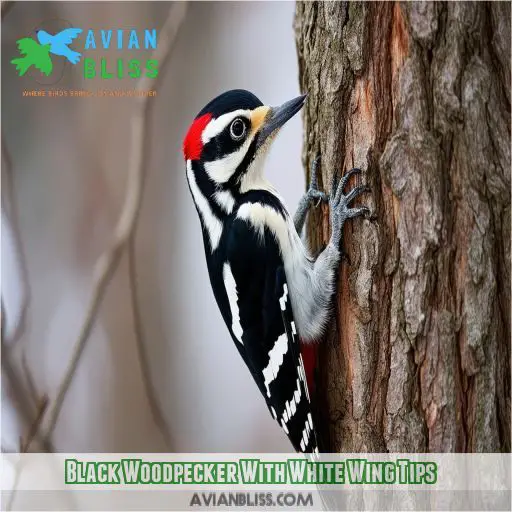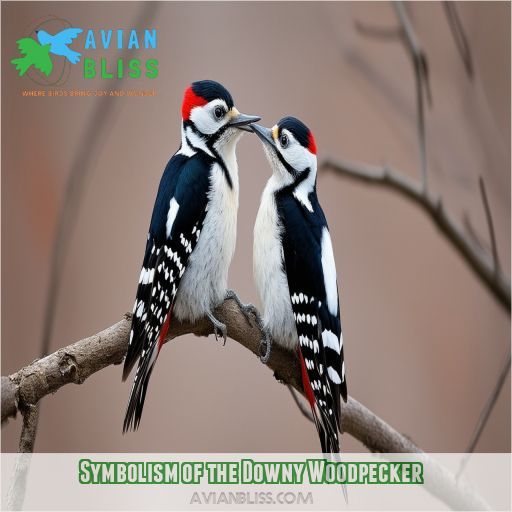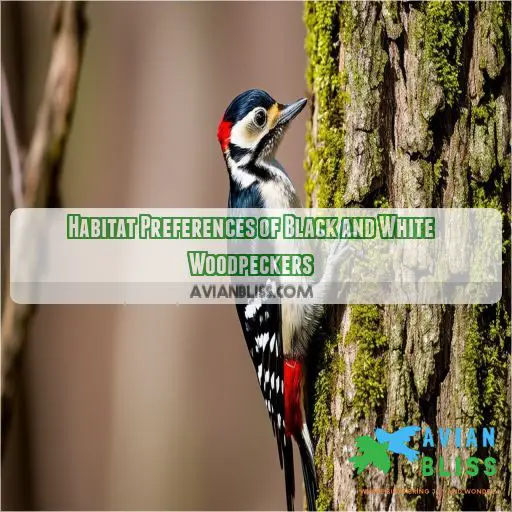This site is supported by our readers. We may earn a commission, at no cost to you, if you purchase through links.

Among them, black and white woodpeckers stand out for their striking plumage.
You’re about to discover 8 stunning species that’ll captivate your imagination.
From the diminutive Downy to the impressive Black Woodpecker, you’ll learn about their unique features, habitats, and behaviors.
Get ready to explore the fascinating world of these black and white beauties, and learn more about these remarkable birds.
Table Of Contents
- Key Takeaways
- Black and White Woodpecker Species
- Downy Woodpecker Rarity
- Black Woodpecker With White Wing Tips
- Symbolism of the Downy Woodpecker
- Plumage Comparison: Downy Vs. Hairy Woodpecker
- Beak Size Variation Among Woodpeckers
- Vocalizations: Woodpecker Call Identification
- Habitat Preferences of Black and White Woodpeckers
- Frequently Asked Questions (FAQs)
- What kind of woodpeckers are black and white?
- Are Downy Woodpeckers rare?
- What kind of woodpecker is black with white wing tips?
- What does the Downy Woodpecker symbolize?
- How long do black and white woodpeckers typically live?
- Can woodpeckers see color or only black and white?
- Do black and white woodpeckers migrate seasonally?
- How fast can a woodpeckers head move while pecking?
- Are there any predators that specifically target woodpeckers?
- Conclusion
Key Takeaways
- These tuxedo-clad tree-tappers come in all shapes and sizes, from the pint-sized Downy to the jumbo-jet-sized Black Woodpecker. Don’t let their snazzy outfits fool you – each species has its own unique flair and habitat preferences!
- Think you’ve got the Downy and Hairy woodpeckers figured out? Think again! These lookalike cousins are the ultimate bird-watching challenge. Pro tip: it’s all in the details – from tail feathers to beak size, these subtle differences separate the woodpecker wannabes from the real deal.
- Who knew these feathered drummers were such chatterboxes? From staccato pecks to full-blown woodpecker symphonies, each species has its own secret language. Tune in, and you might just crack the woodpecker code!
- Don’t write off the humble Downy as just another backyard bird. This pint-sized powerhouse is a symbol of persistence and hidden strength. Next time you spot one, remember: good things come in small packages – and sometimes they’re covered in feathers!
Black and White Woodpecker Species
You’re in for a treat as we explore the fascinating world of black and white woodpeckers!
These striking birds come in various species, each with its unique charm.
From the tiny Downy to the massive Pileated, you’ll find a diverse range of sizes and patterns.
The Downy and Hairy woodpeckers often confuse beginners, but don’t worry – we’ll give you some foolproof identification tips.
Keep an eye out for the elusive Black-backed woodpecker in coniferous forests, or the legendary Ivory-billed woodpecker, if you’re feeling lucky!
These species have adapted to different habitats across North America, from dense woodlands to suburban parks.
Their distribution patterns reflect their remarkable ability to thrive in various environments.
As you get a closer look at woodpeckers, you’ll discover a colorful array of avian diversity right in your backyard!
Downy Woodpecker Rarity
You might think Downy Woodpeckers are a dime a dozen, but don’t let their common appearance fool you!
While these black and white beauties aren’t rare in the traditional sense, their population trends have been a rollercoaster ride.
Habitat loss has been nipping at their heels, threatening their cozy homes in forests and urban areas alike.
But here’s the kicker: these pint-sized peckers are tougher than they look!
Conservation efforts have been giving them a helping hand, ensuring their drumming doesn’t fade into silence.
Still, they’re not out of the woods yet.
From climate change to pesticides, Downy Woodpeckers face an uphill battle.
So next time you spot one of these feathered friends, remember: you’re witnessing a small but mighty survivor in action.
Keep your eyes peeled and your ears open – their distinctive calls are music to a bird lover’s ears!
Black Woodpecker With White Wing Tips
You’ve learned about the Downy Woodpecker’s rarity, but now let’s explore another striking black and white woodpecker species. The Black Woodpecker with white wing tips is a sight to behold. This impressive bird boasts a distinctive pattern that’ll catch your eye in an instant. Here’s what makes it stand out:
- Its jet-black body contrasts sharply with bright white wing tips
- The white patches flash dramatically during flight
- Its size dwarfs many other woodpecker species
While not as common as some black and white woodpeckers, this species has adapted to various habitats. You’ll find them in mature forests, where they use their powerful beaks to excavate large cavities in trees. Their unique coloration isn’t just for show – it plays a role in their bird behavior, potentially aiding in communication and mate selection. Keep your eyes peeled for this stunning woodpecker on your next forest adventure!
Symbolism of the Downy Woodpecker
You might be surprised to learn that the humble Downy Woodpecker carries deep symbolic meaning. This backyard bird isn’t just a cavity nesting expert; it’s a powerful spirit animal in many cultures. Let’s explore the fascinating symbolism behind this tiny drummer:
| Symbolism | Meaning |
|---|---|
| Persistence | Overcoming obstacles with determination |
| Opportunity | Finding hidden resources in life |
| Communication | Expressing yourself clearly |
| Rhythm | Finding balance in daily routines |
| Awakening | Spiritual growth and self-discovery |
When you spot a Downy in its woodpecker habitat or at your feeder, remember it’s more than just a bird watching treat. It’s a reminder to tap into your inner strength, seek out hidden opportunities, and maintain your own unique rhythm in life. So next time you hear that familiar drumming, take a moment to reflect on the Downy’s powerful message.
Plumage Comparison: Downy Vs. Hairy Woodpecker
While the downy woodpecker‘s symbolism resonates with many, let’s shift our focus to a visual puzzle that’s stumped even seasoned birders. You’ve probably spotted these black and white beauties flitting about, but can you tell a downy from a hairy woodpecker? Don’t worry; you’re not alone in this feathered confusion!
At first glance, these two species look like twins. But look closer, and you’ll spot some key differences. The downy’s a pint-sized powerhouse, while the hairy’s a bit beefier. Their plumage patterns are strikingly similar, with both sporting checkered backs and white belly feathers. However, the downy’s outer tail feathers often have black bars, while the hairy’s are typically pure white. Remember, size isn’t everything – these subtle plumage distinctions are your secret weapon for impressing fellow bird enthusiasts!
Beak Size Variation Among Woodpeckers
Now that you’ve learned to distinguish between Downy and Hairy Woodpeckers, let’s take a closer look at the fascinating world of woodpecker beaks.
You’ll be amazed at how these specialized tools vary across species!
The red-headed woodpecker boasts a sturdy, medium-length beak perfect for drilling into wood.
In contrast, the red-bellied woodpecker‘s slightly curved bill is ideal for probing bark crevices.
The yellow-bellied sapsucker sports a shorter, more chisel-like beak for sap extraction.
You’ll notice the white-headed woodpecker’s beak is longer and more slender, adapted for reaching deep into pine cones.
And don’t forget the acorn woodpecker‘s robust bill, designed for hammering acorns into tree bark.
These variations aren’t just for show – they’re the result of millions of years of evolution, fine-tuning each species’ beak to its specific dietary needs and habitat.
Vocalizations: Woodpecker Call Identification
Woodpeckers may drum on houses during mating season to attract a mate or establish territory, and learning how to scare woodpeckers away from house can be crucial to prevent damage. Now that you’re familiar with beak sizes, let’s get into the fascinating world of woodpecker vocalizations. You’ll be amazed at how diverse their calls can be! Recognizing woodpecker sounds is a key skill for any birding enthusiast. The Cornell Lab of Ornithology offers excellent resources for learning bird songs and calls. Here are three key types of woodpecker vocalizations to listen for:
- Drumming: A rapid series of pecks used for communication
- Calls: Short, sharp notes that vary by species
- Songs: Longer, more complex vocalizations used during breeding season
Each black and white woodpecker species has its unique set of sounds. For instance, the Downy Woodpecker’s call is a sharp "pik," while the Hairy Woodpecker’s is a louder "peek." By participating in community science projects, you’ll sharpen your skills in identifying these calls, contributing valuable data to bird research.
Habitat Preferences of Black and White Woodpeckers
You’ll find black and white woodpeckers in a variety of habitats, each with its own preferences. Downy woodpeckers, for instance, are incredibly adaptable. They’ll make themselves at home in forests, parks, and even your backyard! These little acrobats aren’t picky, but they do love areas with plenty of trees.
On the other hand, the red-cockaded woodpecker is quite particular. These endangered birds need mature pine forests with dead trees for nesting. Sadly, habitat loss has hit them hard. That’s where proforestation comes in – letting forests grow old naturally to create perfect woodpecker homes.
Some species, like the hairy woodpecker, have a broader range. They’ll happily inhabit both deciduous and coniferous forests across North America. But remember, all woodpeckers share one key need: trees! Whether it’s for food, shelter, or drumming practice, these feathered percussionists can’t live without their wooden stages.
Frequently Asked Questions (FAQs)
What kind of woodpeckers are black and white?
You’ll find several black and white woodpecker species, including the downy, hairy, and red-headed woodpeckers. They’re easily identifiable by their striking contrasting feathers. These acrobatic birds are common visitors to backyard feeders, especially those offering suet.
Are Downy Woodpeckers rare?
You’ll be pleased to know that Downy Woodpeckers aren’t rare at all. They’re one of North America’s most common woodpeckers. You’ll often spot these small, energetic birds in forests, parks, and even your backyard, drumming away on trees or visiting feeders.
What kind of woodpecker is black with white wing tips?
You’re likely spotting a Hairy Woodpecker. They’re black with white wing tips and a white back. Larger than their Downy cousins, they’ve got longer bills. You’ll often see them on tree trunks or at suet feeders.
What does the Downy Woodpecker symbolize?
With wisdom rivaling ancient philosophers, the Downy Woodpecker symbolizes adaptability and resourcefulness. You’ll find it represents persistence, overcoming obstacles, and attention to detail. It’s a reminder to stay focused and resilient in your daily life.
How long do black and white woodpeckers typically live?
You’ll typically see black and white woodpeckers living 4-12 years in the wild. Their lifespan varies by species, with smaller ones like Downys averaging 5 years, while larger species can reach a decade or more with luck.
Can woodpeckers see color or only black and white?
You’ll be surprised to learn that woodpeckers aren’t limited to a monochrome world. They can see a wide range of colors, just like you. Their color vision helps them navigate their environment and find food effectively.
Do black and white woodpeckers migrate seasonally?
Most woodpeckers don’t migrate, but some northern species do. You’ll find them year-round in their habitats. They’re adaptable, often staying put if food’s available. Some may move short distances to find better resources during harsh winters.
How fast can a woodpeckers head move while pecking?
Whiplash-worthy woodpeckers! You’d be amazed at their pecking prowess. Their heads can move up to 20 times per second, reaching speeds of 15 mph. This rapid rhythm allows them to drill into wood with precision and power.
Are there any predators that specifically target woodpeckers?
You’ll find several predators targeting woodpeckers. Hawks, owls, and snakes are primary threats, while raccoons and squirrels raid nests. Domestic cats pose a risk in urban areas. Woodpeckers’ natural defenses include camouflage and quick reflexes.
Conclusion
Diving into the world of black and white woodpeckers has been a feather in your cap.
You’ve discovered eight stunning species, each with unique features and behaviors.
From the Downy’s rarity to the Black Woodpecker’s impressive size, these birds captivate with their striking plumage and diverse habitats.
You’ve learned about their vocalizations, beak variations, and symbolism.
As you continue to observe these remarkable creatures, remember that their black and white beauty is just the tip of the iceberg in the fascinating world of woodpeckers.











